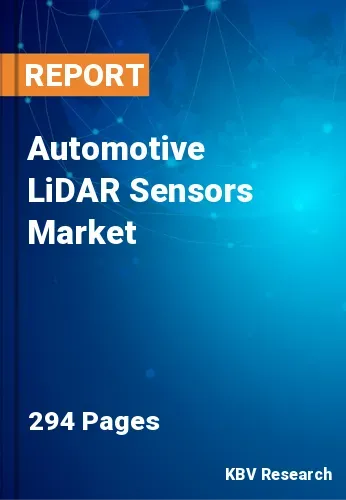The Global Automotive LiDAR Sensors Market size is expected to reach $5.3 billion by 2029, rising at a market growth of 32.1% CAGR during the forecast period.
Light Detection and Ranging is known as LiDAR, and in the automotive sector, most vehicles employ it to navigate areas in real-time. Sonar and LiDAR are similar to each other. In order to comprehend its surroundings, it fires pulsed laser waves in all directions. It measures the depth of an item using laser rays. Any object within a 60-meter radius can be checked for proximity using this device. In order to navigate the environment, it may make a 3D map of the area.
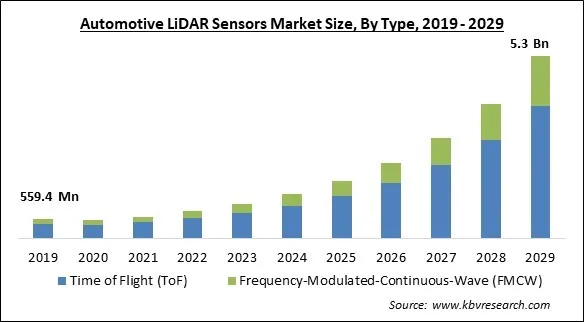
This characteristic is crucial for driverless vehicles. LiDAR technology has significant advantages for Level 3 (semi-autonomous) and Level 4 (autonomous) vehicle automation. The majority of automakers engaged in autonomous car development employ LiDAR technology. LiDAR provides autonomous vehicles with the ability to "see" by producing and analyzing millions of data points in real time, creating a precise map of the continuously shifting environment around the vehicle for secure navigation.
As autonomous vehicles acquire popularity and grow more and more critical for safety and accident prevention, the market for automotive LiDAR sensors is growing swiftly. Additionally, a rise in market players' innovations—such as the integration of sensor technology into LiDAR point clouds via feature extraction and clustering to sense the barriers more effectively—is anticipated to open up lucrative opportunities for the growth of the automotive LiDAR sensors market throughout the projected period.
The COVID-19 pandemic has caused a diversion of government funding towards the healthcare sector, which has significantly impacted the market for automotive LiDAR sensor projects. As a result, the establishment of new projects has slowed down. However, The automotive LiDAR sensors market has shown signs of recovery following the lifting of lockdown restrictions and the implementation of large-scale vaccination programs globally. Therefore, it is expected that the market for automotive LiDAR sensors will experience a positive growth trend after facing a sharp reduction in sales during the starting phase of the pandemic.
Several LiDAR sensor companies are dedicated to creating affordable LiDAR sensors by integrating all components onto a single chip. Some of these companies have received funding from government agencies. In addition, numerous venture investors are showing interest in startups developing cost-effective and improved LiDAR sensors for self-driving cars. As a result, the cost of LiDAR sensors is expected to decrease gradually, based on the trend observed in other automotive technologies. Hence, due to the constant technological advancement, the wider need and utilization of vehicle sensors like automotive LiDAR sensors will propel the market growth.
Road traffic injuries can substantially impact the financial well-being of individuals and their families. The expenses associated with treating injuries can be significant, and fatalities or disabilities can decrease productivity. Furthermore, there is also a significant impact on business resulting from these injuries. Road traffic injuries significantly impact nations' economies, resulting in a loss of 3% of their yearly gross domestic product. As LiDAR sensors in vehicles can aid the driver in detecting collision beforehand and, furthermore, get the vehicle under control with the utilization of various other ADAS systems, their utilization is expected to surge and thereby provide growth opportunities for the market.
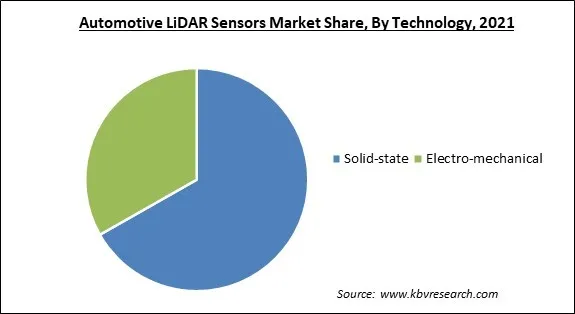
Automotive LiDARs are thought to be difficult and expensive at the moment. The massive size, complexity, and expense of the devices hamper the commercialization of automobile LiDAR sensors. Due to this, the pool of potential customers is anticipated to shrink as a result of the integration of these LiDARs into an autonomous system, which will increase the sticker price of the autonomous system. Even though LiDAR is anticipated to become less expensive as technology advances, the high cost of the system is currently preventing its adoption and limiting the market growth for automotive LiDAR sensors.
Based on type, the automotive LiDAR sensors market is segmented into time of flight (ToF) and frequency-modulated-continuous-wave (FMCW). The time of flight (ToF) segment dominated the automotive LiDAR sensors market with maximum revenue share in 2022. This is due to the fact that time of flight is a 3D imaging and scanning technology that is highly active. Time-of-Flight (ToF) technology offers superior speed, reliability, and energy efficiency for 3D imaging compared to structured light and stereo vision. Due to its cost-effectiveness, ToF technology is anticipated to experience an increase in requests for 3D imaging and scanning purposes.
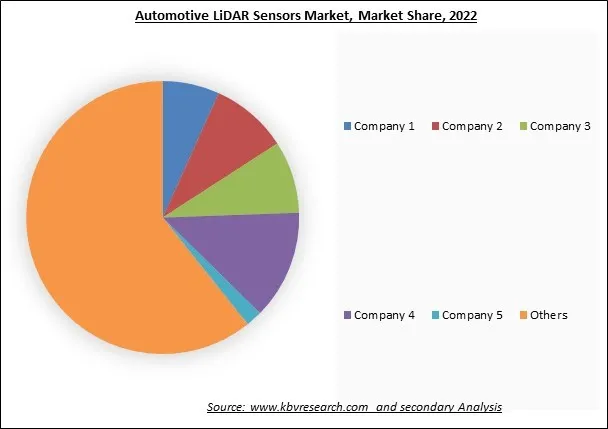
The leading players in the market are competing with diverse innovative offerings to remain competitive in the market. The below illustration shows the percentage of revenue shared by some of the leading companies in the market. The leading players of the market are adopting various strategies in order to cater demand coming from the different industries. The key developmental strategies in the market are Product Launches and Product Expansions.
On the basis of technology, the automotive LiDAR sensors market is divided into solid-state and electro-mechanical. The electro-mechanical segment procured a substantial revenue share in the automotive LiDAR sensors market in 2022. This is because electro-mechanical LIDARs are a type of LIDAR system that is commonly used in the automotive industry. They are often referred to as first-generation LIDAR sensors. The LIDAR system sensors utilize multiple moving parts to generate and discharge an array of laser beams toward the target region.
By image type, the automotive LiDAR sensors market is classified into 2 dimensional and 3 dimensional. The 3 dimensional segment garnered a prominent revenue share in the automotive LiDAR sensors market in 2022. This is because 3D technology caters to various industries such as commercial vehicles, automotive, construction, agriculture, mining, infrastructure inspection, UAV delivery, and more. The 3D image type allows a seamless pixel alignment with no missing data. They offer a high vertical and horizontal resolution with co-registered intensity and range for optimal performance.
Based on the vehicle type, the automotive LiDAR sensors market is bifurcated into internal combustion engine (ICE), hybrid and battery electric. The battery electric segment recorded a promising growth rate in the automotive LiDAR sensors market in 2022. This is owing to the fact that autonomous vehicle technology in electric vehicles represents the future of transportation in the short, medium, and long term. Novel applications are being created to enable public transportation, delivery of goods, and other specific applications. Accurately identifying and categorizing objects within the vehicle's surroundings is crucial for predicting paths and enhancing safety measures.
On the basis of application, the automotive LiDAR sensors market is divided into semi-autonomous vehicles and autonomous vehicles. The semi-autonomous vehicles segment led the automotive LiDAR sensors market by generating the maximum revenue share in 2022. This is because, in semi-autonomous vehicles, the driver retains the primary responsibility of operating the vehicle while being assisted by a range of ADAS features such as LiDAR. LiDAR-based features can enhance safety measures by offering early warnings and additional support in steering or controlling vehicles, thereby reducing the likelihood of crashes and accidents.
| Report Attribute | Details |
|---|---|
| Market size value in 2022 | USD 792.2 Million |
| Market size forecast in 2029 | USD 5.3 Billion |
| Base Year | 2022 |
| Historical Period | 2019 to 2021 |
| Forecast Period | 2023 to 2029 |
| Revenue Growth Rate | CAGR of 32.1% from 2023 to 2029 |
| Number of Pages | 294 |
| Number of Table | 494 |
| Report coverage | Market Trends, Revenue Estimation and Forecast, Segmentation Analysis, Regional and Country Breakdown, Market share analysis, Competitive Landscape, Companies Strategic Developments, Company Profiling |
| Segments covered | Type, Technology, Vehicle Type, Image Type, Application, Region |
| Country scope | US, Canada, Mexico, Germany, UK, France, Russia, Spain, Italy, China, Japan, India, South Korea, Singapore, Malaysia, Brazil, Argentina, UAE, Saudi Arabia, South Africa, Nigeria |
| Growth Drivers |
|
| Restraints |
|
Region-wise, the automotive LiDAR sensors market is analyzed across North America, Europe, Asia Pacific, and LAMEA. The North America region generated the highest revenue share in the automotive LiDAR sensors market in 2022. The growth is attributed to the rising need for LiDAR sensors in autonomous vehicle delivery. Furthermore, the government's focus on achieving net zero emissions is expected to drive the demand for electric vehicles, thereby fueling market growth in the region during the forecasted period.
Free Valuable Insights: Global Automotive LiDAR Sensors Market size to reach USD 5.3 Billion by 2029
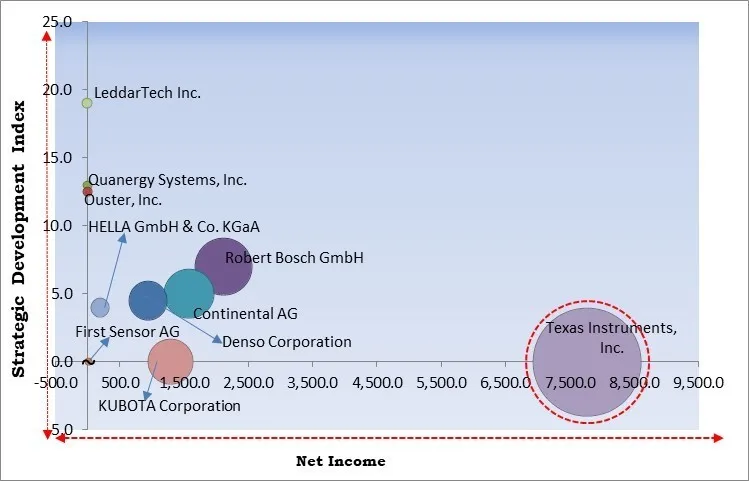
The major strategies followed by the market participants are Product Launches. Based on the Analysis presented in the Cardinal matrix; Texas Instruments, Inc. is the forerunner in the Automotive LiDAR Sensors Market. Companies such as Robert Bosch GmbH, LeddarTech Inc., and Continental AG are some of the key innovators in Automotive LiDAR Sensors Market.
The market research report covers the analysis of key stake holders of the market. Key companies profiled in the report include Robert Bosch GmbH, Continental AG, Denso Corporation, Ouster, Inc., HELLA GmbH & Co. KGaA, First Sensor AG (TE Connectivity Ltd.), Texas Instruments, Inc., KUBOTA Corporation, Quanergy Systems, Inc. and LeddarTech Inc.
By Type
By Technology
By Vehicle Type
By Image Type
By Application
By Geography


The Market size is projected to reach USD 5.3 billion by 2029.
The advancements in autonomous vehicle technology are driving the market in coming years, however, The high cost of the LiDAR sensors decreasing their adoption restraints the growth of the market.
Robert Bosch GmbH, Continental AG, Denso Corporation, Ouster, Inc., HELLA GmbH & Co. KGaA, First Sensor AG (TE Connectivity Ltd.), Texas Instruments, Inc., KUBOTA Corporation, Quanergy Systems, Inc. and LeddarTech Inc.
The expected CAGR of this market is 32.1% from 2023 to 2029.
The Solid-state segment acquired maximum revenue share in the Global Automotive LiDAR Sensors Market by Technology 2022 thereby, achieving a market value of $3.4 billion by 2029.
The North America market dominated the Market by Region 2022, and would continue to be a dominant market till 2029; thereby, achieving a market value of $1.8 billion by 2029.
Our team of dedicated experts can provide you with attractive expansion opportunities for your business.
